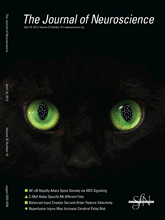J Neurosci:脑细胞变化导致老年人睡眠困扰
2012-04-27 Beyond 生物谷
据发表在4月25日的Journal of Neuroscience杂志上的一项最新研究证实:老年动物大脑中调控睡眠和清醒周期的“时钟”细胞发生了变化。这一发现可能有助于解释为什么老年人会受到晚上睡眠和白天昏昏欲睡的困扰。 像人类一样,老鼠随着年龄增长,其日常活动和睡眠模式发生了改变。研究人员为了找出原因,荷兰莱顿大学医学中心的研究人员博士研究视交叉上核(SCN)大脑区域中细胞的电活动,视交叉上核
据发表在4月25日的Journal of Neuroscience杂志上的一项最新研究证实:老年动物大脑中调控睡眠和清醒周期的“时钟”细胞发生了变化。这一发现可能有助于解释为什么老年人会受到晚上睡眠和白天昏昏欲睡的困扰。
像人类一样,老鼠随着年龄增长,其日常活动和睡眠模式发生了改变。研究人员为了找出原因,荷兰莱顿大学医学中心的研究人员博士研究视交叉上核(SCN)大脑区域中细胞的电活动,视交叉上核主要控制睡眠觉醒周期。
与以往的研究一致,研究人员发现老年小鼠表现出睡眠紊乱的行为,SCN中大脑网络活动被削弱。但Meijer和他的同事们还发现,个别SCN细胞发生了变化,并不只是在他们的网络中。
Meijer表示:事实上,单细胞水平上的变化比在网络层面的变化更为严重。
研究人员从分离的SCN神经元进行了电生理记录。他们发现老年SCN神经元缺乏一些膜性能的日夜节率。此外研究小组发现了与年龄有关的对某些神经元有节奏非常重要的钾电流减少了。
研究人员表示:因为可以用药物调节钾等离子通道,这项工作为潜在的治疗干预,减轻与年龄有关的睡眠觉醒周期紊乱提供了新方法。

doi:10.1523/JNEUROSCI.5750-07.2008
PMC:
PMID:
Excitatory Actions of GABA in the Suprachiasmatic Nucleus
Hee Joo Choi1,*, C. Justin Lee2,*, Analyne Schroeder3, Yoon Sik Kim1, Seung Hoon Jung1, Jeong Sook Kim1, Do Young Kim1, Eun Ju Son1, et al.
Neurons in the suprachiasmatic nucleus (SCN) are responsible for the generation of circadian oscillations, and understanding how these neurons communicate to form a functional circuit is a critical issue. The neurotransmitter GABA and its receptors are widely expressed in the SCN where they mediate cell-to-cell communication. Previous studies have raised the possibility that GABA can function as an excitatory transmitter in adult SCN neurons during the day, but this work is controversial. In the present study, we first tested the hypothesis that GABA can evoke excitatory responses during certain phases of the daily cycle by broadly sampling how SCN neurons respond to GABA using extracellular single-unit recording and gramicidin-perforated-patch recording techniques. We found that, although GABA inhibits most SCN neurons, some level of GABA-mediated excitation was present in both dorsal and ventral regions of the SCN, regardless of the time of day. These GABA-evoked excitatory responses were most common during the night in the dorsal SCN region. The Na+-K+-2Cl− cotransporter (NKCC) inhibitor, bumetanide, prevented these excitatory responses. In individual neurons, the application of bumetanide was sufficient to change GABA-evoked excitation to inhibition. Calcium-imaging experiments also indicated that GABA-elicited calcium transients in SCN cells are highly dependent on the NKCC isoform 1 (NKCC1). Finally, Western blot analysis indicated that NKCC1 expression in the dorsal SCN is higher in the night. Together, this work indicates that GABA can play an excitatory role in communication between adult SCN neurons and that this excitation is critically dependent on NKCC1.
本网站所有内容来源注明为“梅斯医学”或“MedSci原创”的文字、图片和音视频资料,版权均属于梅斯医学所有。非经授权,任何媒体、网站或个人不得转载,授权转载时须注明来源为“梅斯医学”。其它来源的文章系转载文章,或“梅斯号”自媒体发布的文章,仅系出于传递更多信息之目的,本站仅负责审核内容合规,其内容不代表本站立场,本站不负责内容的准确性和版权。如果存在侵权、或不希望被转载的媒体或个人可与我们联系,我们将立即进行删除处理。
在此留言








#ROS#
51
#脑细胞#
72